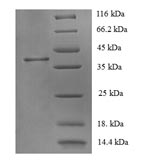Recombinant Human Corticotropin-releasing factor receptor 1 (CRHR1) is produced through an E. coli expression system and represents a partial protein segment spanning amino acids 24 to 121. The protein carries an N-terminal GST tag to help with purification and detection. SDS-PAGE analysis confirms the product maintains a purity level above 90%, which appears to provide good reliability for research work. This product is meant strictly for research use and cannot be used for therapeutic purposes.
CRHR1 seems to be a key player in the corticotropin-releasing hormone signaling pathway. The receptor likely plays an important role in how we handle stress by controlling the hypothalamic-pituitary-adrenal (HPA) axis. This makes CRHR1 particularly interesting for scientists studying stress responses, brain function, and hormone systems - offering a useful target for research into the molecular details of these complex processes.
Potential Applications
Note: The applications listed below are based on what we know about this protein's biological functions, published research, and experience from experts in the field. However, we haven't fully tested all of these applications ourselves yet. We'd recommend running some preliminary tests first to make sure they work for your specific research goals.
GPCRs require precise seven-transmembrane domain folding within a lipid membrane environment, along with specific post-translational modifications like glycosylation. This partial fragment, representing only a portion of the extracellular domain (24-121aa), lacks the full structural context and cannot form the complete ligand-binding pocket. The bacterial expression system cannot provide the necessary membrane environment or eukaryotic folding machinery. Therefore, this recombinant protein is highly unlikely to achieve a native-like conformation or possess functional ligand-binding activity.
1. Antibody Development and Validation
This recombinant CRHR1 fragment serves as an excellent immunogen for generating antibodies specific to this extracellular region of human CRHR1. The high purity and defined sequence ensure specific antibody production. However, antibodies generated against this bacterially expressed fragment may primarily recognize linear epitopes and might not efficiently bind to the properly folded, glycosylated form of the receptor on the cell surface in native tissues.
2. ELISA-Based Screening and Detection Assays
This protein is well-suited as a standard for immunoassay development to measure antibody binding or as a coating antigen. However, it is completely unsuitable for functional screening of receptor-ligand interactions. It can be used in ELISA formats to screen for antibodies or to compete for antibody binding, but not to study CRF binding to the receptor.
Final Recommendation & Action Plan
This recombinant CRHR1 protein is limited to non-structural, immunological uses. The protein can be reliably used for Application 1 (Antibody Development) and Application 2 (as an immunoassay standard). Interaction studies and binding studies are not recommended as they require the native, full-length receptor structure in a membrane environment. For functional studies of CRHR1, the only valid path is to use a full-length receptor expressed in mammalian cells or native tissue preparations.






